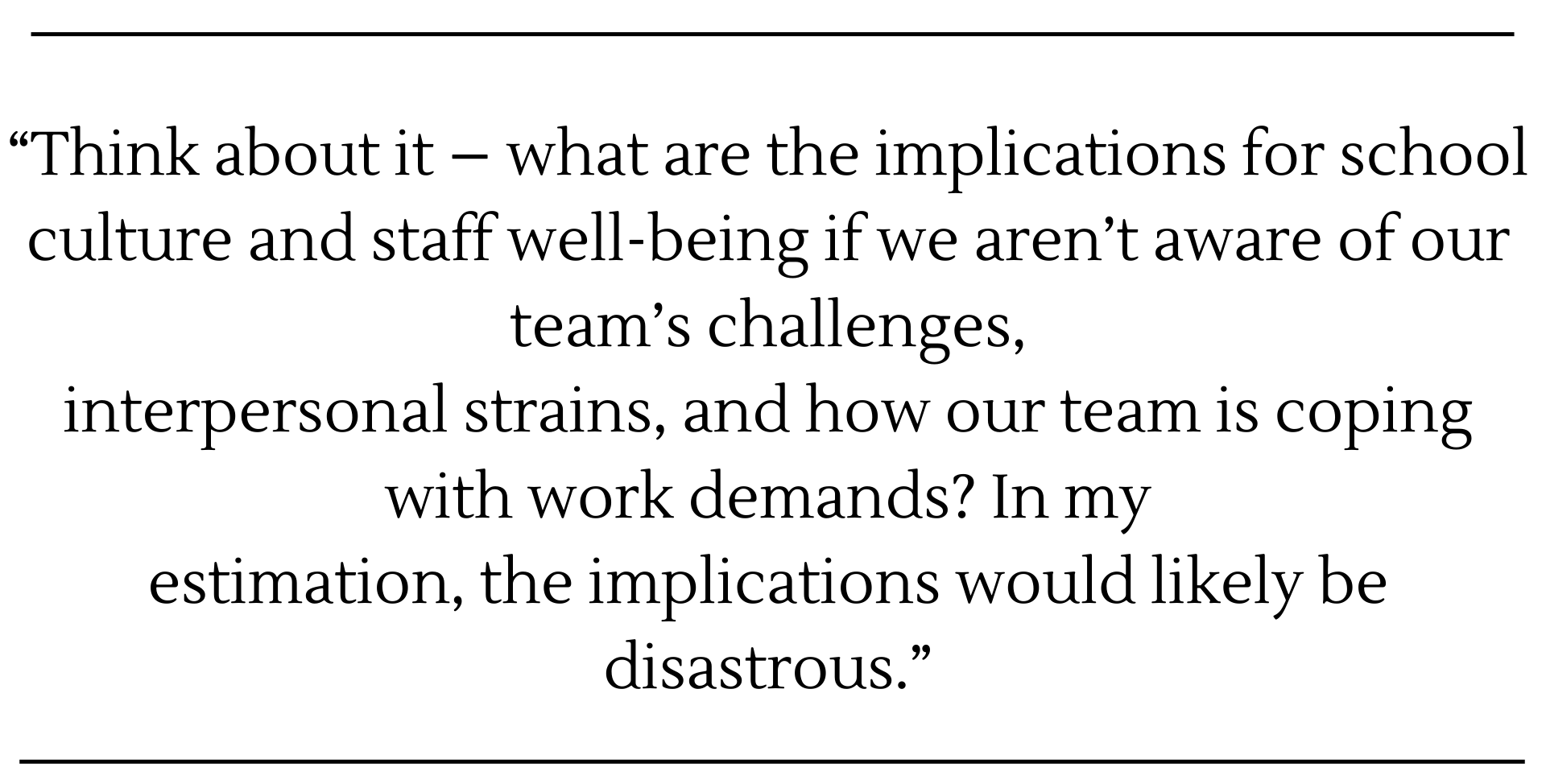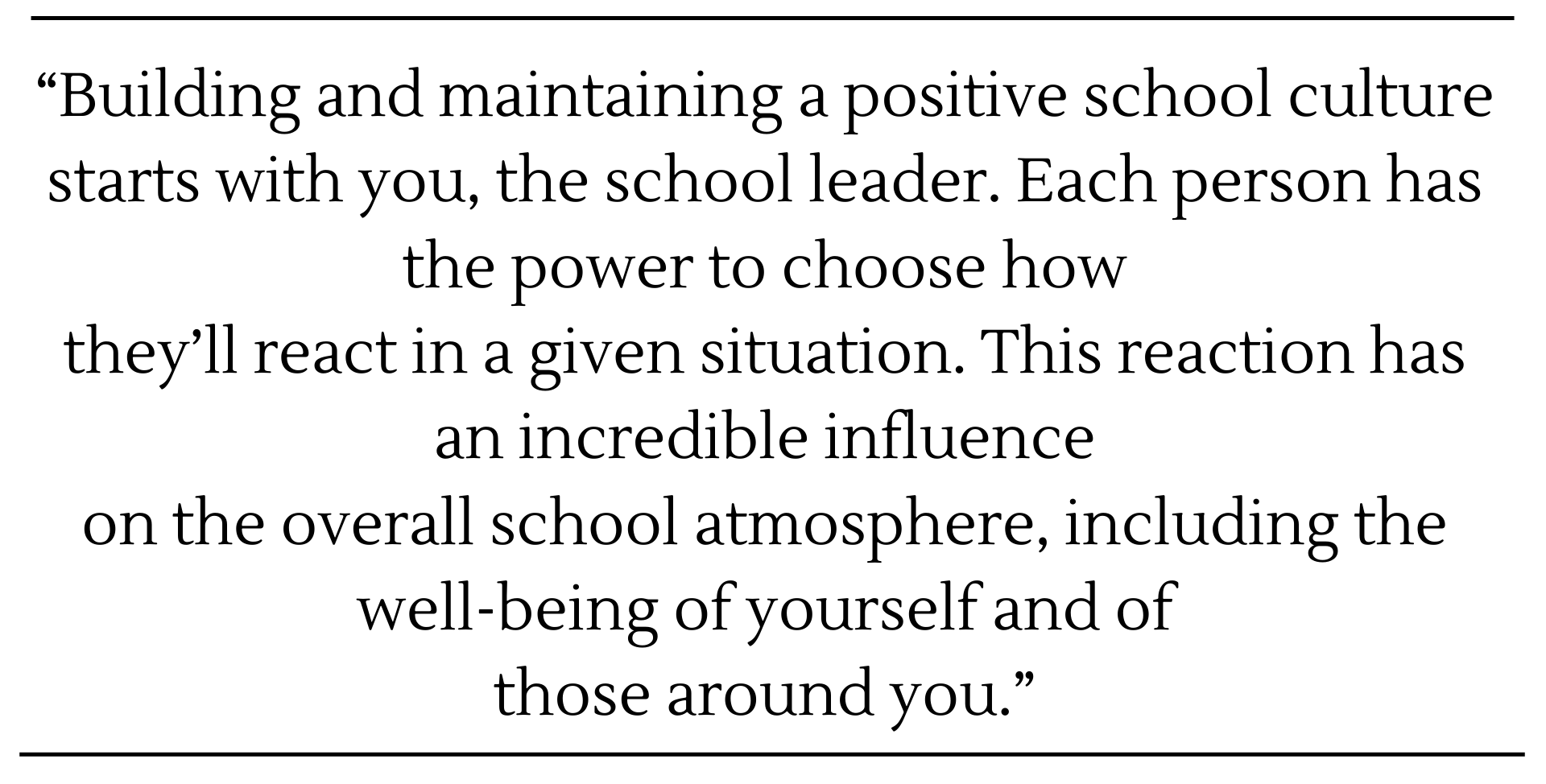Leading despite your job title
2 ways that school principals can open up lines of communication and build healthy teams
If you had to describe the culture of your school, what would you say? If the students, parents, or staff in your school community were asked to describe your school’s culture, what would THEY say? And what’s the impact of this culture on the well-being of your staff?
The term “school culture” refers to our beliefs, attitudes, perceptions, and ways of doing things, including the quality of the relationships that are developed between colleagues and with students. Culture is often based on both written rules (i.e. a code of conduct) and unwritten rules (i.e. how staff believe they should act and behave, or what behaviour they think is expected of them).

Whether we like it or not, even if our intentions don’t change as we transition towards a leadership role within a school, our job title often leads us to become blocked off from certain channels of information that we may have previously had access to.
Ed Catmull, author of the book Creativity Inc., explains it like this: “As my position changed, people became more careful how they spoke and acted in my presence. I don’t think my actions changed in a way that prompted this; my position did. And what this meant was that things I’d once been privy to became increasingly unavailable to me.”
Ed Catmull goes on to say that many new leaders often make the mistake of assuming that their access to these information channels hasn’t changed. He calls this phenomenon “The Hidden”: a blind spot that escapes our field of perception. Ed’s words remind me of the importance of being continually and intentionally looking for these so-called “blind spots.”
Think about it – what are the implications for school culture and staff well-being if you aren’t aware of your team’s challenges, interpersonal strains, and how your team is coping with work demands? In my estimation, the implications would likely be disastrous. As school leaders, we are stewards of culture and well-being, and so it’s up to us to raise the atmosphere and lead the change that we’d like to see. But how do we stay connected to the “true pulse” of our school culture? In other words, how do we stay constantly in the know about how staff are truly feeling in the workplace, despite our job title?

As a principal myself, I’ve been practicing two winning approaches to ensure that I’m in the loop with how staff are actually living out the culture that we seek to build, while opening up channels of information and communication. The first approach targets staff personal growth, while the second approach targets staff collective development and team spirit.
Approach #1: Monthly individual meetings
During the school year, I invite each of my staff to optional monthly coaching meetings, which usually take around 15-to-30 minutes. Meeting dates are selected in advance and marked down in our calendars. In short, we make these meetings a priority.
During these meetings, we set goals and discuss pedagogy or any other subject that has an impact on their personal and professional growth. In short, these conversations allow us to get to know each other better.

Above all, these meetings provide me with vital information that allows me to help maintain the well-being of my staff members, while allowing me to know where they’re at in terms of classroom pedagogy or other projects they’re undertaking throughout the school year.
Approach #2: Scrum-style team meetings
Instead of holding traditional monthly staff meetings, we organize “Scrum” meetings every two weeks. The goals of these meetings include sharing successful practices, keeping informed, promoting peer support, building team spirit, and ensuring positive mental health.

Here are five key elements of our Scrum-style team meetings:
1. Members must stand during the meeting
2. Each person is invited to answer three questions:
- What’s something new that I did, or something that worked well, that I could share with the team?
- What am I going to do that could be helpful to the team?
- What do I need?
3. Each person has up to three minutes to share their thoughts
4. A “Scrum Master” is designated to lead the meeting
5. A timekeeper is designated to ensure each person gets their three minutes to share.
These meetings not only allow us to learn about what each person does in their respective roles, but also grants us the opportunity to celebrate successes, offer support, ask questions, get to know each other, and laugh together. At the end of each meeting, people often stay behind to continue on the conversation, and leave with a smile on their face including a sense of satisfaction and pride in knowing that they have an important place on our team. It’s a really fantastic experience!

Maintaining a culture of staff well-being starts with you.
We all have a responsibility in helping maintain a positive school culture. But as in all workplaces, there are times when things go less-than-well and negativity can infiltrate itself into our culture.
How do you respond in these less-than-well situations?
A. Do you become easily bogged down with the negative? Is your first reaction to complain or to judge, or to react strongly on your emotions?
OR
B. Are you quick to stomp down the negative? Do you demonstrate empathy by offering help or solutions instead of judgment? Do you take the time to listen carefully so as to truly understand the situation, rather than merely provide answers?
Let’s take a few moments to think about this – do you find yourself mostly acting like A or like B? When faced with change or challenge, what position do you adopt – one that is more creative or one that is reactive?
Personally, I always strive to adopt a creative position when faced with challenges. When I allow my growth mentality to take the lead, this gives way to positivity and optimism, which in turn feeds my creativity and allows me to arrive at new solutions. Choosing to be creative has an invaluable and positive impact on well-being, and leads to increased confidence, hope, and energy – all of which keep our “bucket full.”

Building and maintaining a positive school culture starts with you, the school leader. Each person has the power to choose how they’ll react in a given situation. This reaction has an incredible influence on the overall school atmosphere, including the well-being of yourself and of those around you. That’s why it’s so important to never lose sight of the influence we have as leaders each and every day through the words we speak and the actions we undertake.
Photo: Adobe Stock
